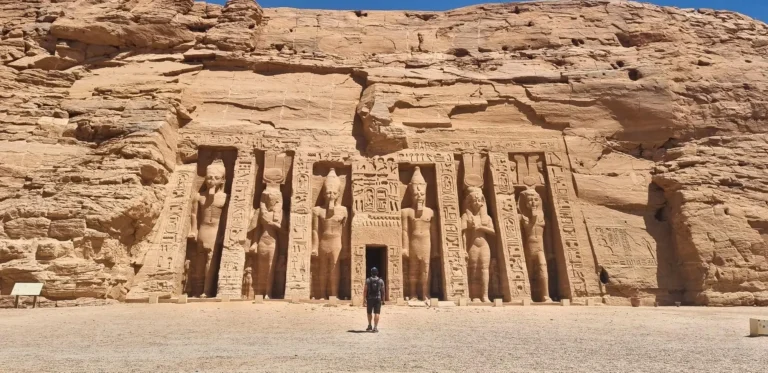
VISITING ABU SIMBEL TEMPLES IN EGYPT: 9 TIPS
Here are 9 tips for visiting the Abu Simbel Temples in Egypt: from where they are located to how to get there and where to sleep!

Here is our 7-day itinerary in Egypt, travelling along the Nile from Cairo to Abu Simbel to experience the true soul of this magical country!
Egypt is a country with ancient origins, and there are places to visit that will transport us back thousands of years. From the capital, Cairo, to Abu Simbel on the border with Sudan, there are loads of archaeological sites that are definitely worth a visit!
With a 7-day trip, you can check out most of them if you plan your itinerary right!
In this article, we’re going to share our 7-day Egypt itinerary to help you plan your trip and see all the best places in Egypt in 7 days.
A 7-day trip to Egypt is a unique experience, during which you can get to know the local culture in depth and be transported back in time and savour some of the atmosphere of the Pharaoh era. Along the course of the Nile, the source of life in Egypt, major cities have sprung up, where you will find incredible sites that you can visit during your 7-day Egypt discovery trip.
In this article, we propose our 7-day itinerary in Egypt, which we have followed in order to visit this beautiful country, from north to south, following the course of the Nile.
This itinerary starts from the city of Luxor (where we arrived on our flight), goes down to Abu Simbel, and ends with a visit to Cairo. It does not include places on the coast but, if you have more than 7 days available, it might be a great idea to end your trip with a relaxing break on the Red Sea!
You can follow this itinerary in two different ways: by car+plane or cruise+car+plane!
We opted for the second option, which allowed us to enjoy the view of the Nile and its banks throughout the journey and we assure you that it is a truly unique experience! Obviously, the cost is different between the first and second choice but the itinerary we propose can be followed either way!
Would you like to book a Nile cruise where you can follow the stages of this itinerary at a reasonable price? We recommend you take a look at this link!
As for hotels, this itinerary includes overnight stays in Luxor, Aswan, Abu Simbel and even Cairo! Want to know where we stayed? We post the links below!
A very important tip we want to give you for following this itinerary is to always take plenty of water with you, because the excursions are strenuous and some last a whole day! Wear light, breathable clothes, e.g. cotton and linen, always keep your head covered to protect you from the sun, but above all, remember to slather yourself with plenty of sun cream!!!

🏺Luxor: Thebes Hotel ⭐Trip To Try Choice
⚱️ Abu Simbel: Seti Abu Simbel Lake Resort ⭐Trip To Try Choice
📜 Il Cairo: Egypt Pyramids Inn ⭐Trip To Try Choice
🐪 Aswan: Kana Kato ⭐Trip To Try Choice
The first day of this 7-day Egypt discovery itinerary is also one of the most challenging days. It involves, in fact, visiting all the most beautiful and important sites on the western shore of the city of Luxor.
Luxor was the capital of the New Kingdom during the Pharaonic Era (3200-321 BC). It was built around the Nile, which divides it into the part on the west bank, i.e., the city of the dead where the sun sets, and the part on the east bank, where the sun rises and, consequently, called “the city of the living.”
For this reason, all monuments such as tombs and funerary temples are located on the west bank, while celebratory temples are located on the east bank.
Our first day of this itinerary starts from the western shore of Luxor. The first stop is the Valley of the Kings, a complex of tombs of the Pharaohs where 63 tombs have currently been found. However, only a few tombs have been saved from looting and, therefore, are in good condition. Among them, Tutankhamun’s is the most famous and the only one completely intact.
Not all tombs are open at the same time, so 6-7 tombs are accessible on a rotating basis every 2-3 months (in addition to Tutankhamun’s). The ticket to visit the Valley of the Kings includes access to 3 tombs of your choice, whereas, for Tutankhamun’s tomb you will have to purchase a separate ticket.
In addition to Tutankhamun’s tomb, we recommend you visit the tomb of Ramses IV, with its finely decorated corridor and ceiling where the colors have remained almost intact, the tomb of Ramses I, decorated with blue and azure tones, and, finally, the tomb of Ramses III, which is larger than the previous ones.
In summary, the Valley of the Kings is an exceptional place and cannot, therefore, be missed on your trip to Egypt!
Opening hours: 6 a.m. to 5 p.m. in summer, 6 a.m. to 4 p.m. in winter and during Ramadan period
Entrance fee: 600 EGP(about €11.40)
Our tips: the Valley of the Kings is located in a mountain and the ground is rocky and dusty, so we recommend you wear tennis shoes
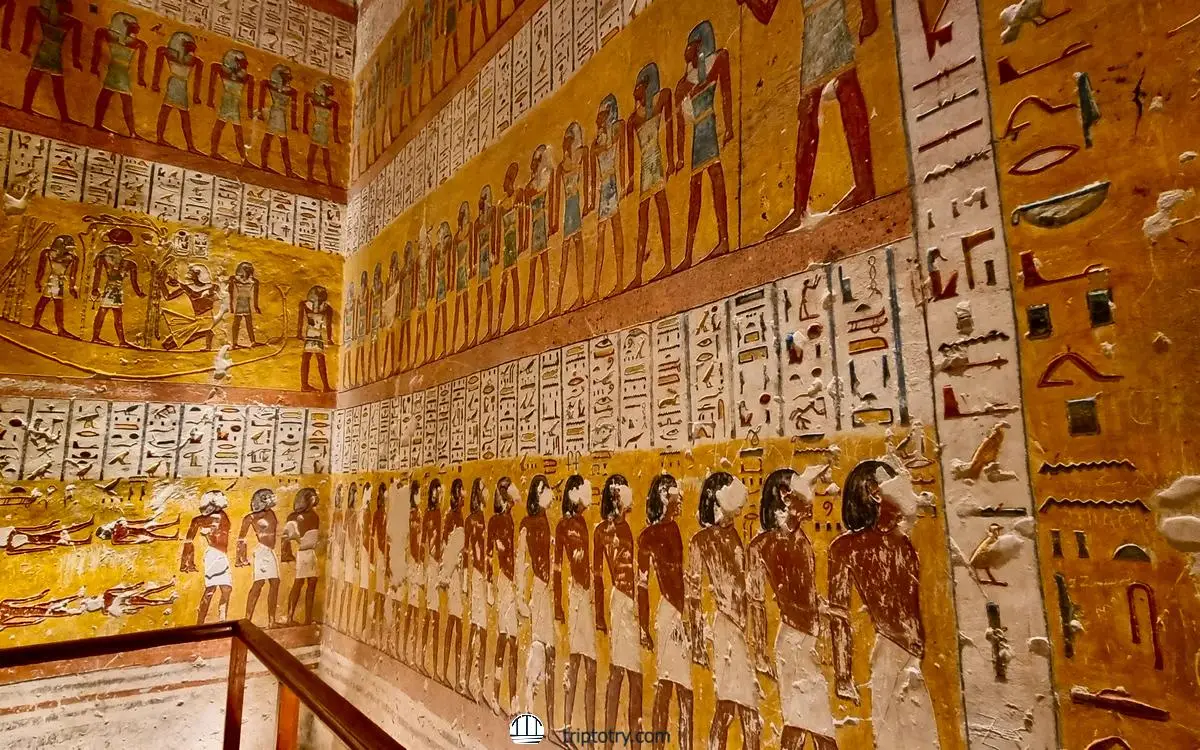
Details in the tomb of Ramses IV
Once the visit to the Valley of the Kings is over, we continue on to the second stop: the Temple of Queen Hatshepsut, which is just a few minutes away. This temple was entirely rebuilt in the 1800s, and its characteristics are its considerable size and location at the foot of the high cliffs of Deir el-Bahari.
It is the funerary temple of Queen Hatshepsut, the second woman to rule Egypt, proclaiming herself co-regent with her grandson Thutmose III.
The temple is laid out on three terraced levels, the third of which is decorated with statues depicting Hatshepsut as a man, in order to emphasize her right to rule.
Arriving at the third level is the central part of the temple, where the shrine is also located.
Opening hours: 6 a.m. to 5 p.m. in summer, 6 a.m. to 4 p.m. in winter and during Ramadan period
Entrance fee: 360 EGP(about €6.90)

ARE YOU INTERESTED IN A GUIDED TOUR OF LUXOR’S WESTERN SHORE?
🏺 Buy your Valley of the Kings and Queens tour HERE.
The third stop on this first day in Egypt is the funerary temple of Ramses III, also known as the Temple of Habu, which was opened to the public a few months ago and is one of the best-preserved temples in Luxor. This temple was dedicated the God Amun and features a wonderful hall of columns where the colors are still intact.
While it is not one of the most famous sites in Luxor, we definitely recommend that you include this temple to your itinerary as it is one of the best preserved of all the sites we visited.
Opening hours: 6 a.m. to 5 p.m. in summer, 6 a.m. to 4 p.m. in winter and during Ramadan period
Entrance fee: 200 EGP(about €3.80)
The last stop on the west bank is what remains of the temple of Amenothep III, namely the Colossi of Memnon. These two enormous statues, 18 meters high, stood at the entrance to the temple and are the tallest colossi that have come down to us still partially intact.
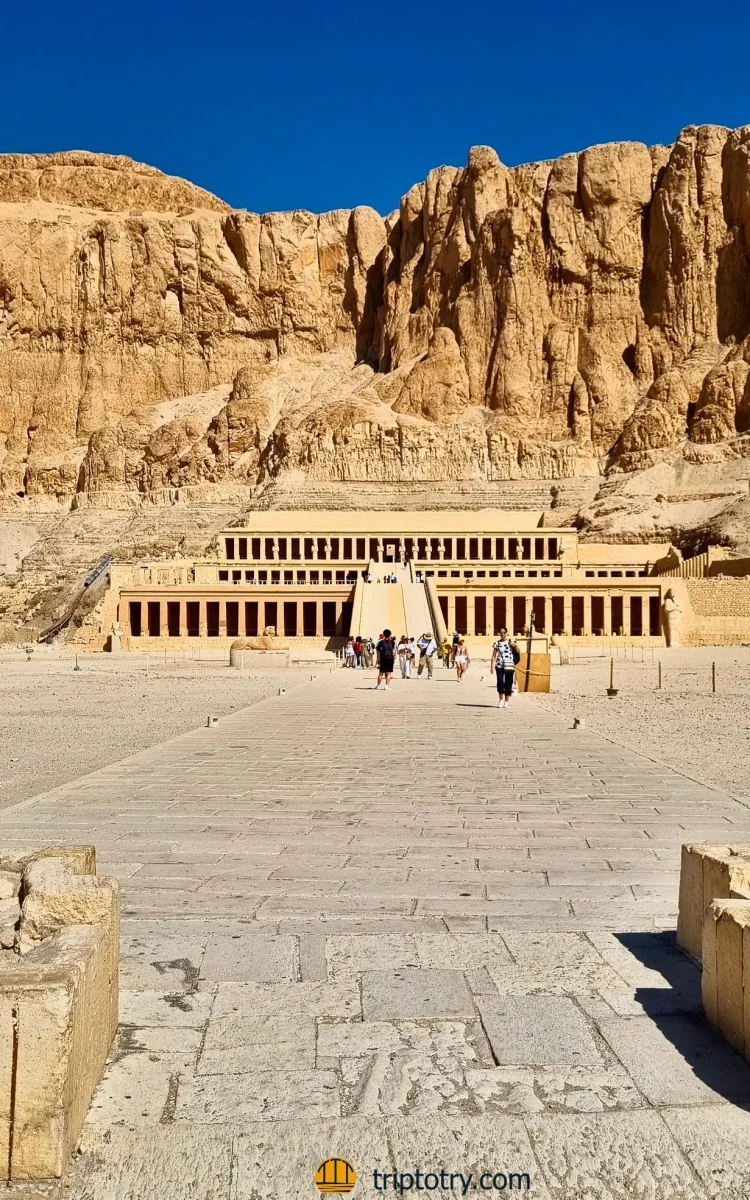
Hatshepsut'S temple
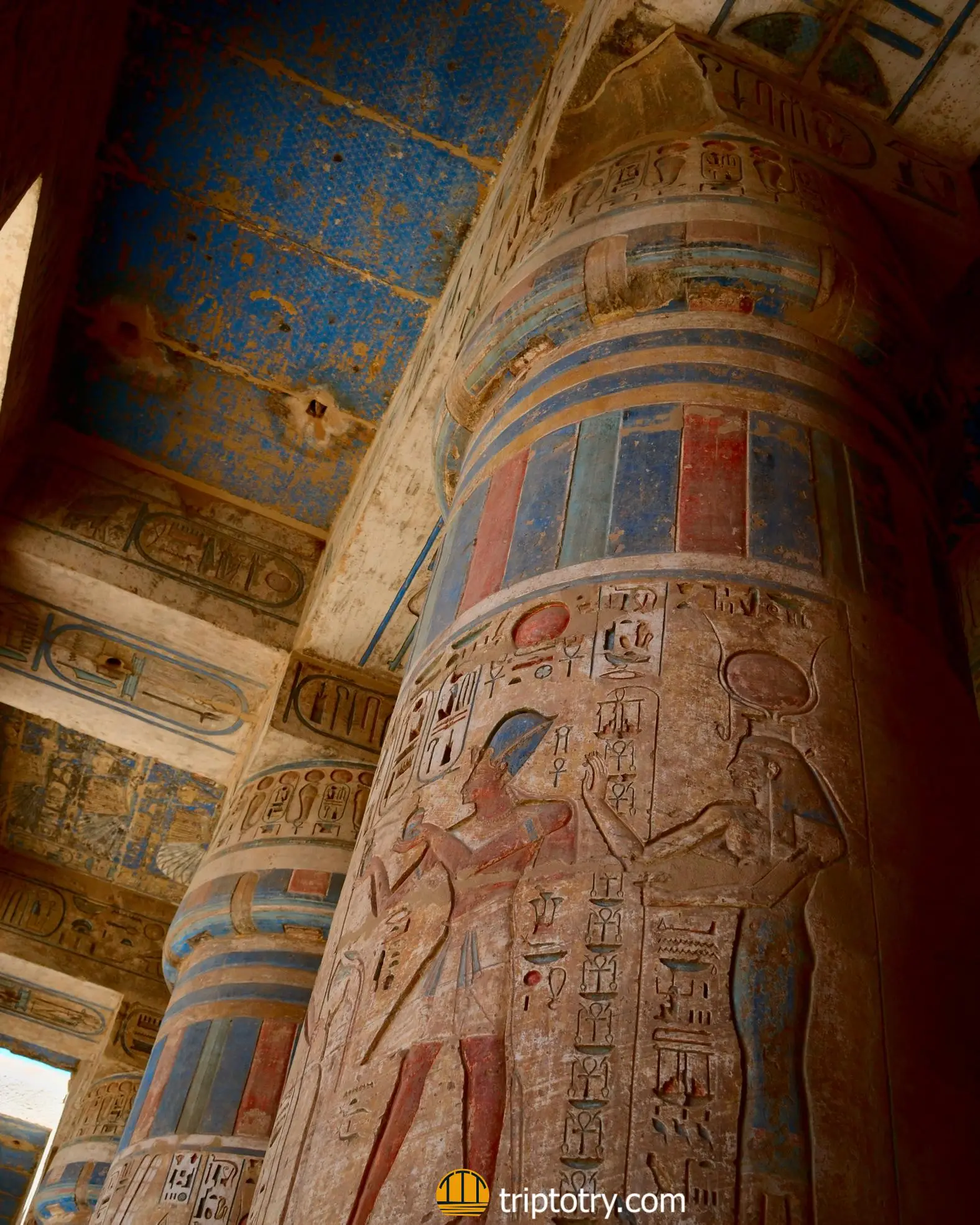
The temple of Habu or Ramses III
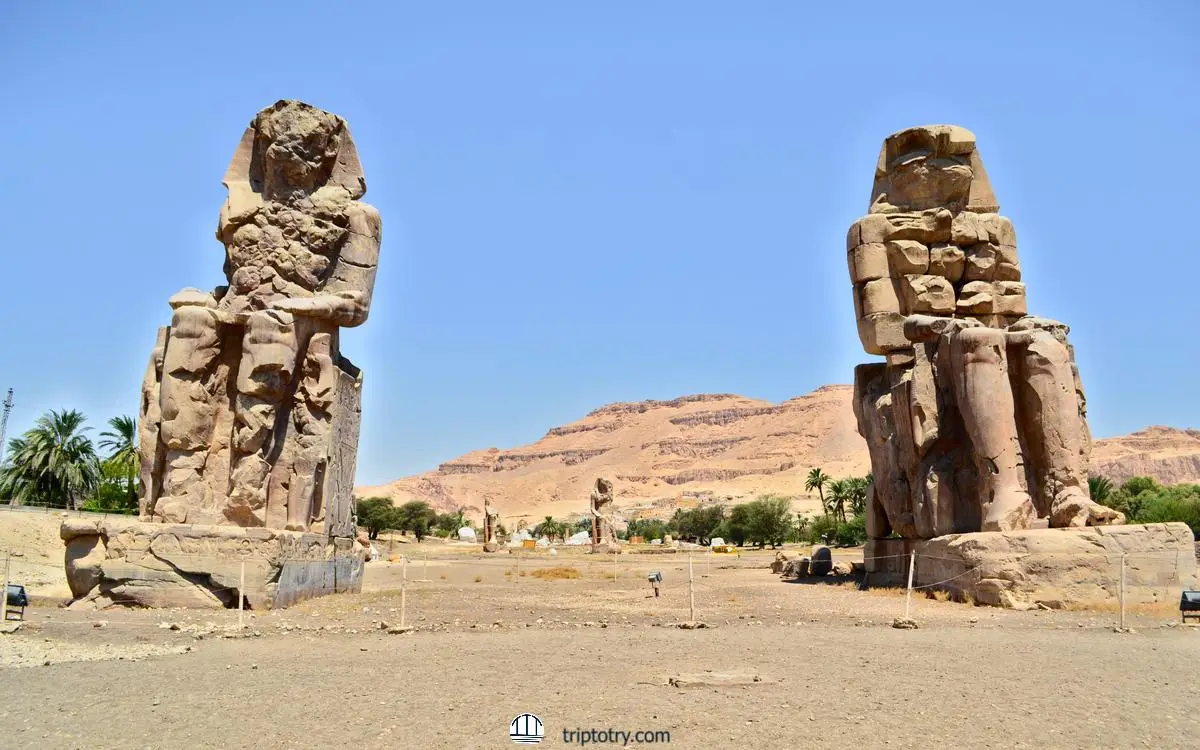
Colossi of Memnon

💰Low budget: Thebes Hotel ⭐Trip To Try Choice
💰💰Medium budget: Sonesta St. George Hotel
💰💰💰💰No limits: Sofitel Winter Palace Luxor
Our 7-day Egypt itinerary moves for the second day to the eastern shore of Luxor, exploring the city’s two most famous celebratory temples, the Temple of Karnak and the Temple of Luxor.
The temple of Karnak was built over the course of 2,000 years, during which each pharaoh made his own contribution to the construction or addition of new parts. This fact was discovered through the presence of cartouches in the decorations bearing the names of successive pharaohs. This temple was connected to the Nile by the Avenue of the Aries, a long street lined with statues depicting the ram, the symbol of the god Amun, and the largest obelisk (of Hatshepsut) and scarab found in Egypt are found there.
One of the most famous spaces in the temple of Karnak is definitely the Hall of Columns, which have an impressive size and height: it is said that it takes ten men to span a column, and the height of the most imposing central columns reaches about 23 meters.
Opening hours: 6 a.m. to 4 p.m.
Entrance fee: 450 EGP(approximately €8.60)
Our tips: this temple is one of the most visited sites in Luxor, if you have a chance get here very early in the morning so you can visit it at your leisure
The temple of Luxor is located not far from that of Karnak ,to which it was connected by the famous Avenue of the Sphinxes, a long street lined with statues of sphinxes that led from one temple complex to another.
This temple was built in about 30-35 years: the inner part of the temple was commissioned by Amenothep III, and the outer part and the avenue of Sphinxes by Pharaoh Ramses II. Some additions were made to the temple in Ptolemaic times by Alexander the Great.
The temple provides access into a large courtyard made by Ramses II, surrounded by columns, from which one enters the main areas, namely the hypostyle hall, the temple dedicated to Amun and then proceeds to the ceremonial halls and shrines. The shrines were partly reconstructed as the temple was damaged by natural events and looting until it was listed as a UNESCO heritage site.
If you want to have a magical experience, we recommend that you return to visit the Luxor temple after dinner, when the light and sound show is held. It is a very beautiful and engaging show that will tell you the story of the Egyptian people and this temple. Unfortunately, you suffer a bit from the light coming from the city and the traffic noise, not like in Abu Simbel where this kind of show definitely gives its best.
Opening hours: 6 a.m. to 7 p.m.
Entrance fee: 400 EGP(approximately €7.60)
Our tips: if you have a chance, the sunset time will make the visit to this temple even more impressive!
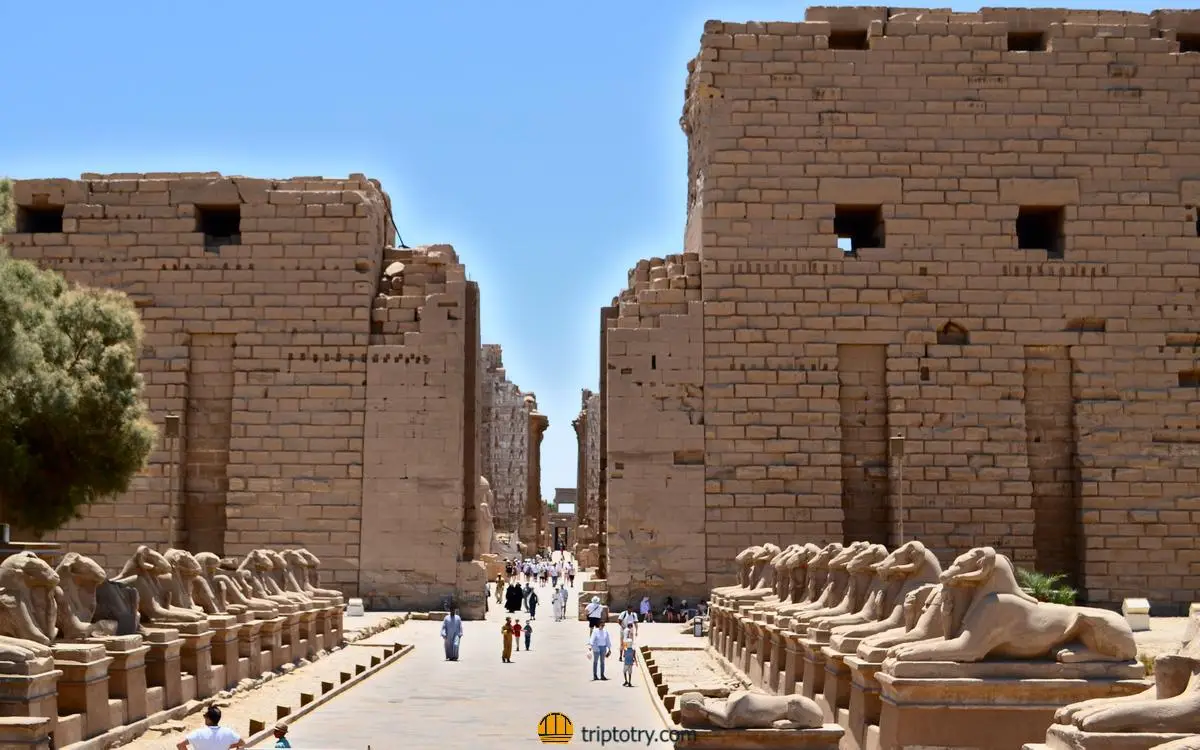
Avenue of the Rams at the Temple of Karnak
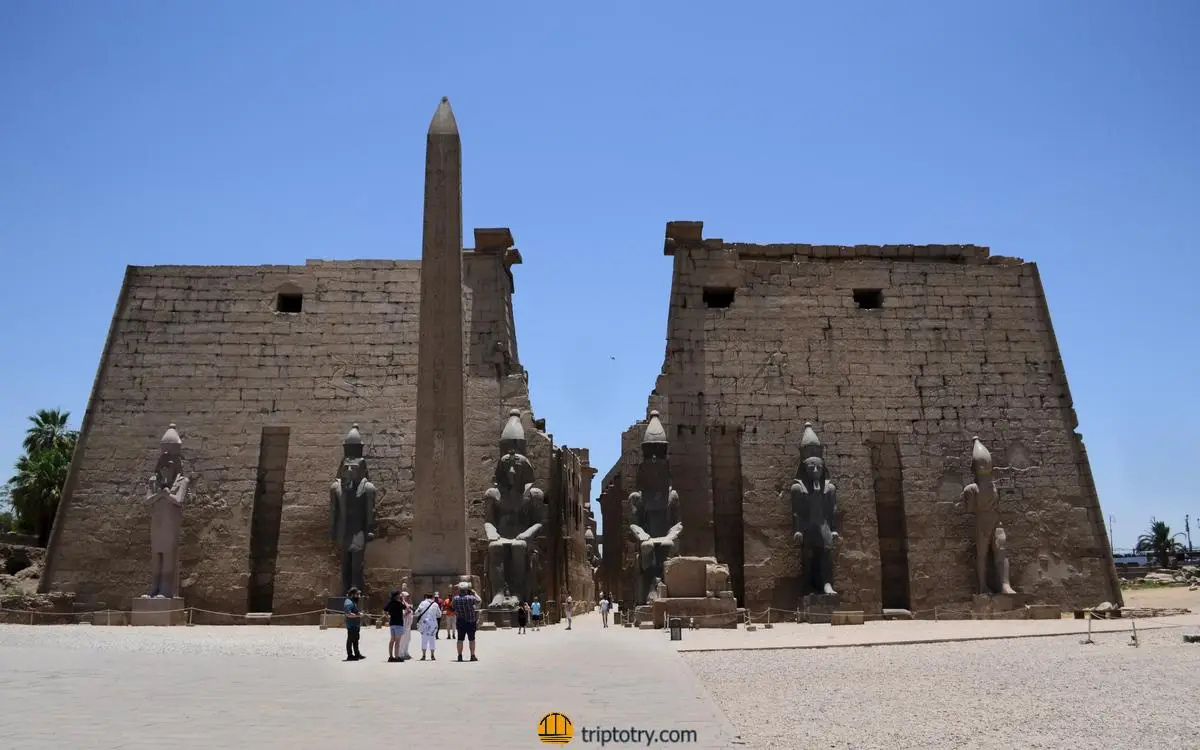
The temple of Luxor
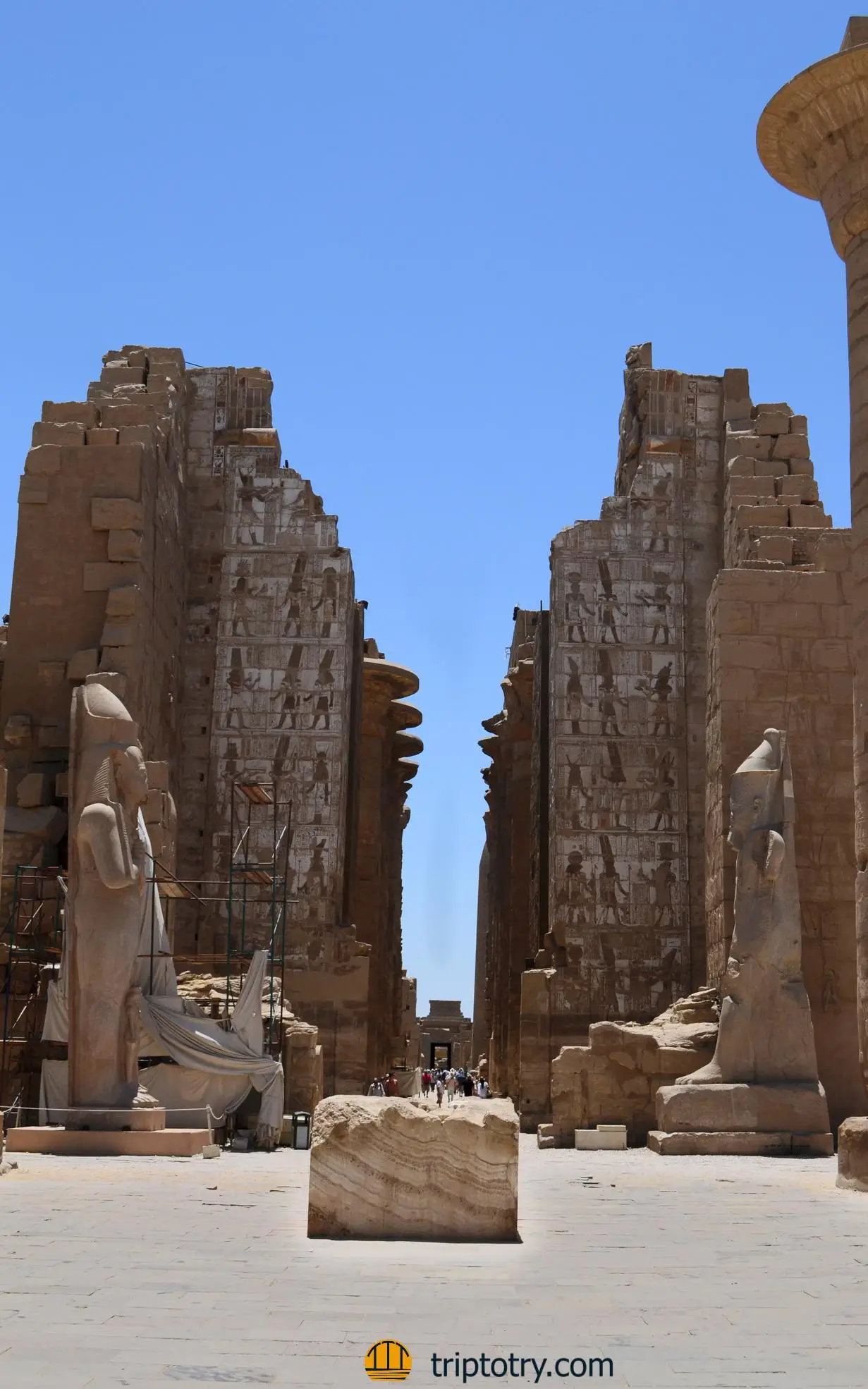
Entrance to the Hall of Columns in the Temple of Karnak
If you’re short on time, you can still cram these two days into a single day tour of Luxor. It’ll be a bit of a rush, but we promise it’s doable!
Day three of our Egypt itinerary involves a visit to the site of Edfu, located south of Luxor at a distance of about two and a half hours by car.
The temple is very large and the visit will take you approximately a couple of hours. Its construction took approximately 200 years (180 B.C.-20 A.D.) during the Greek/Tolomaic era. The temple is dedicated to the Egyptian god Horus, usually represented by a falcon, and on the walls are recounted the many battles against his uncle Seth, the god of war.
This temple is different from those in Luxor in that it features various architectural elements from the classical period, highlighting the influences of Greek culture.
Unfortunately, the decorations on the walls of this temple were severely damaged or, to be precise, chiseled away during the Arab reign. This havoc stands to underscore the will to destroy ancient Egyptian belief: the Egyptian gods were no longer to exist.
The facade of the temple is impressive, and we recommend a long visit to the beautiful side corridors of the temple.
Opening hours: 6 a.m. to 4 p.m.
Entrance fee: 450 EGP(about €7.60)
After visiting the temple of Edfu, we continue the route of this 7-day itinerary, proceeding south until we reach the temple of Kom Ombo.
We visited this place at sunset and we assure you that the evening atmosphere in this temple is truly magical.
The temple of Kom Ombo was built after the temple of Edfu, during the Ptolemaic/Roman era. It was dedicated to two deities: the god Sobek, the god of water and war, and the god Horus, son of the goddess Hathor. Other deities are also celebrated in the temple: the goddess Hathor, the goddess of the sky, and the god Khonsu, god of the moon and youth.
In this temple you will find many decorations, such as those depicting the goddess Hathor as a heifer (a symbol of fertility), one of the earliest representations of the Egyptian calendar, and images of the god Sobek depicted as a crocodile, a sacred animal for the Egyptian people.
The Kom Ombo temple is smaller than the one at Edfu and will take approximately one hour to visit.
At the end of your visit to Kom Ombo Temple, we recommend you make a brief stop at the Crocodile Museum. In fact, this museum is located next to the exit of the temple, and here you can learn something about the worship of this animal. You will also find several mummies on display (some very big!).
Opening hours: 6 a.m. to 8 p.m.
Entrance fee: 360 EGP(approximately €6.90)
Our tips: this site has longer opening hours than the others, and we recommend you visit at sunset because the atmosphere will be truly magical!
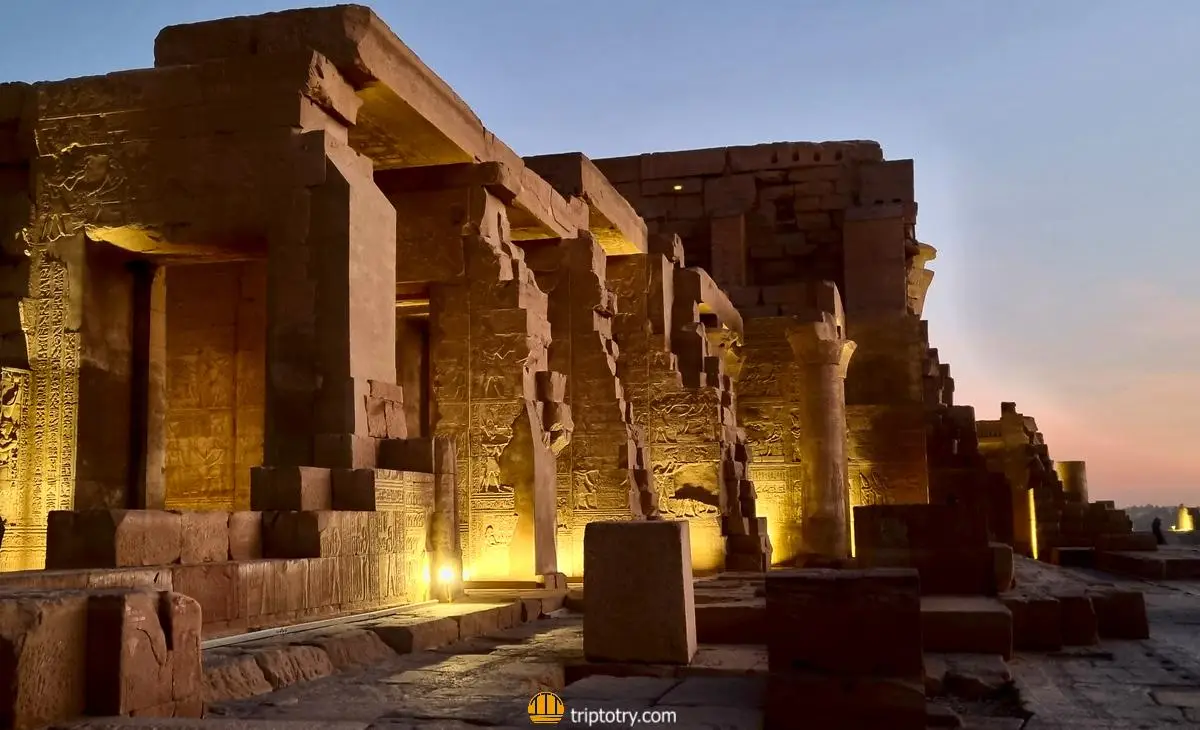
Temple of Kom Ombo
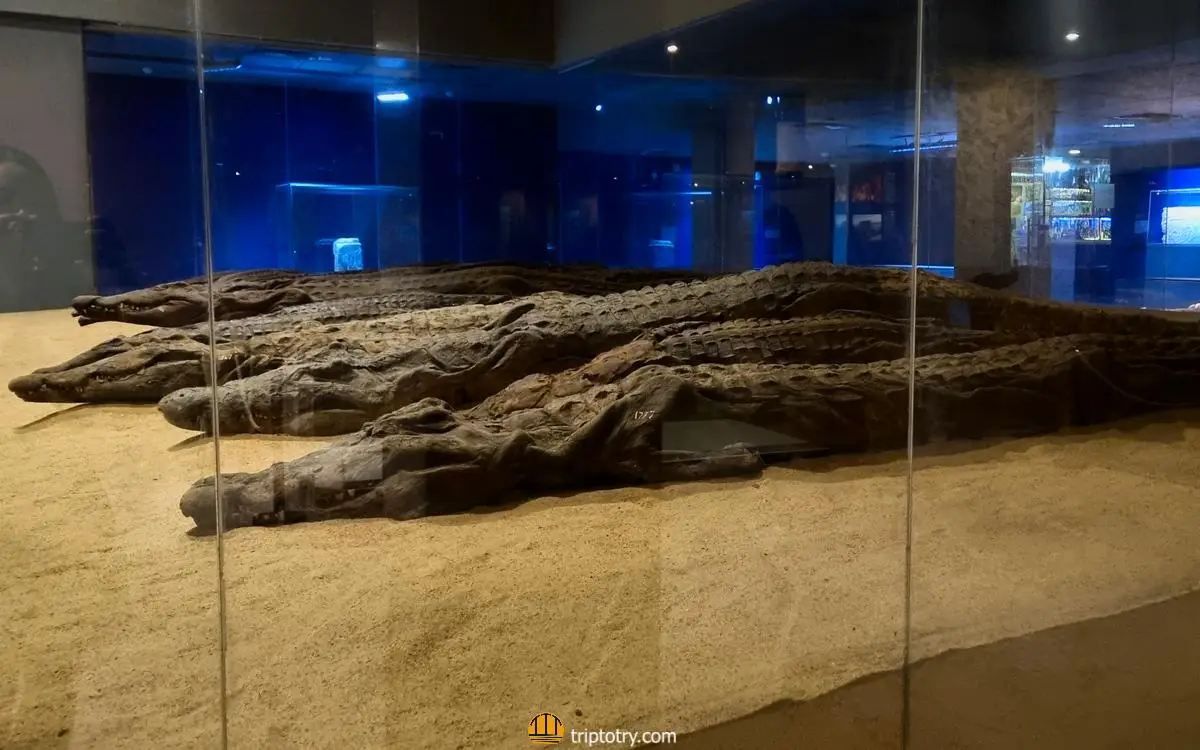
Crocodile Museum
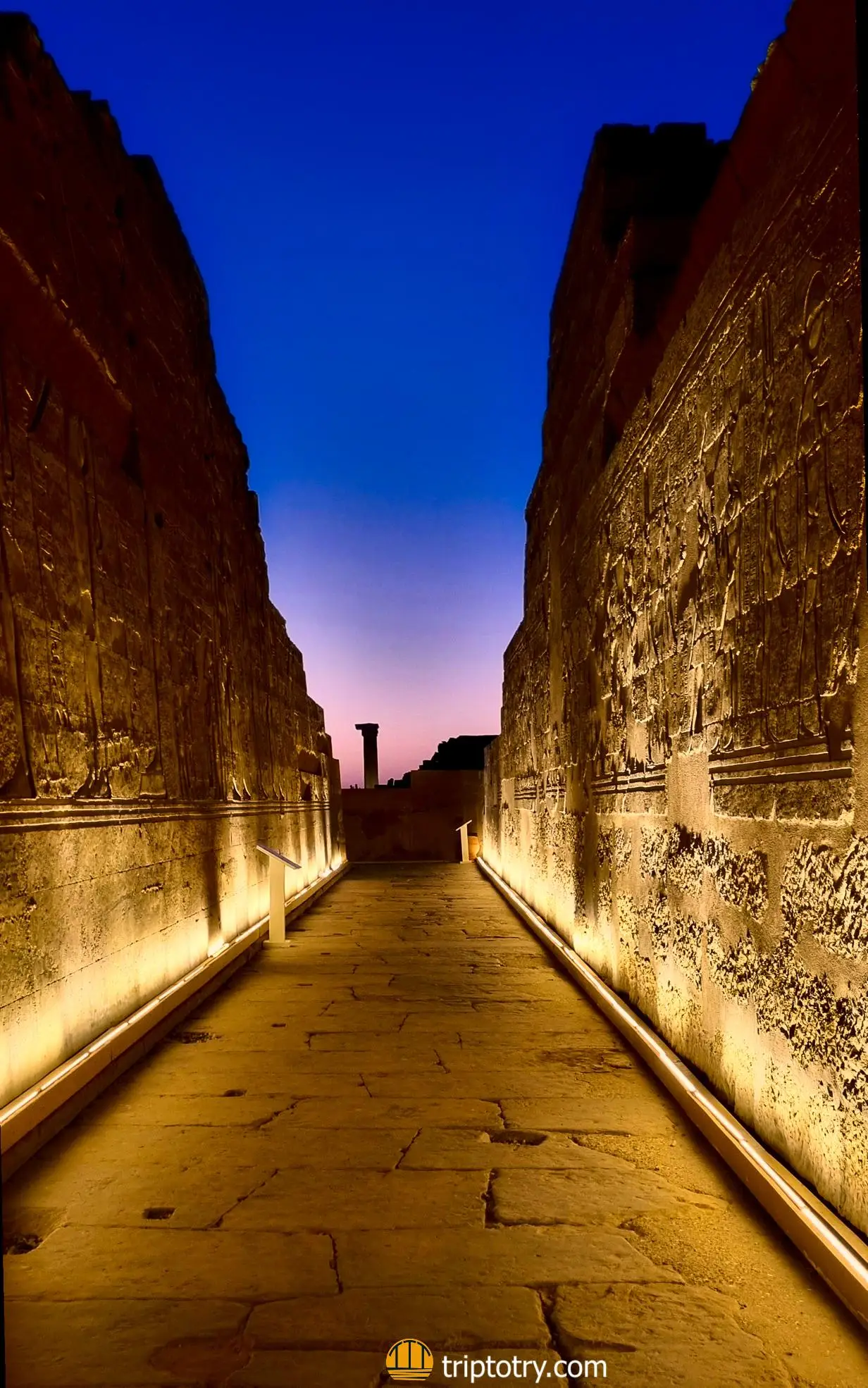
Temple of Kom Ombo

💰Low budget: The Mango Guest House
💰💰Medium budget: Kana Kato ⭐Trip To Try Choice
💰💰💰💰No limits: Sofitel Legend Old Cataract
The fourth day of our itinerary takes us even further south to the city of Aswan.
Aswan is a very important city for the Egyptian economy, in fact many residents move there in search of work. Not only that, there is significantly less chaos and smog in this city than in Cairo.
The first stop on this fourth day is the Aswan Dam, one of the most important works for Egypt’s economic development.
In fact, this dam made it possible to solve the problem of the floods of the Nile, which destroyed and submerged whatever was built on the banks.
This made it possible to cultivate around the river (at the expense of less fertile soil since the dam does not let through the quintessential Egyptian fertilizer: silt) and to build villages and settlements. The Aswan Dam was built in 1970 by President Nasser, and involved the formation to the south of the Lake Nasser Dam, a reservoir of water so large that it reached as far as Sudan.
These reservoirs of man-made water submerged large areas of land, such as those inhabited by the Nubian people, who had to move northward.
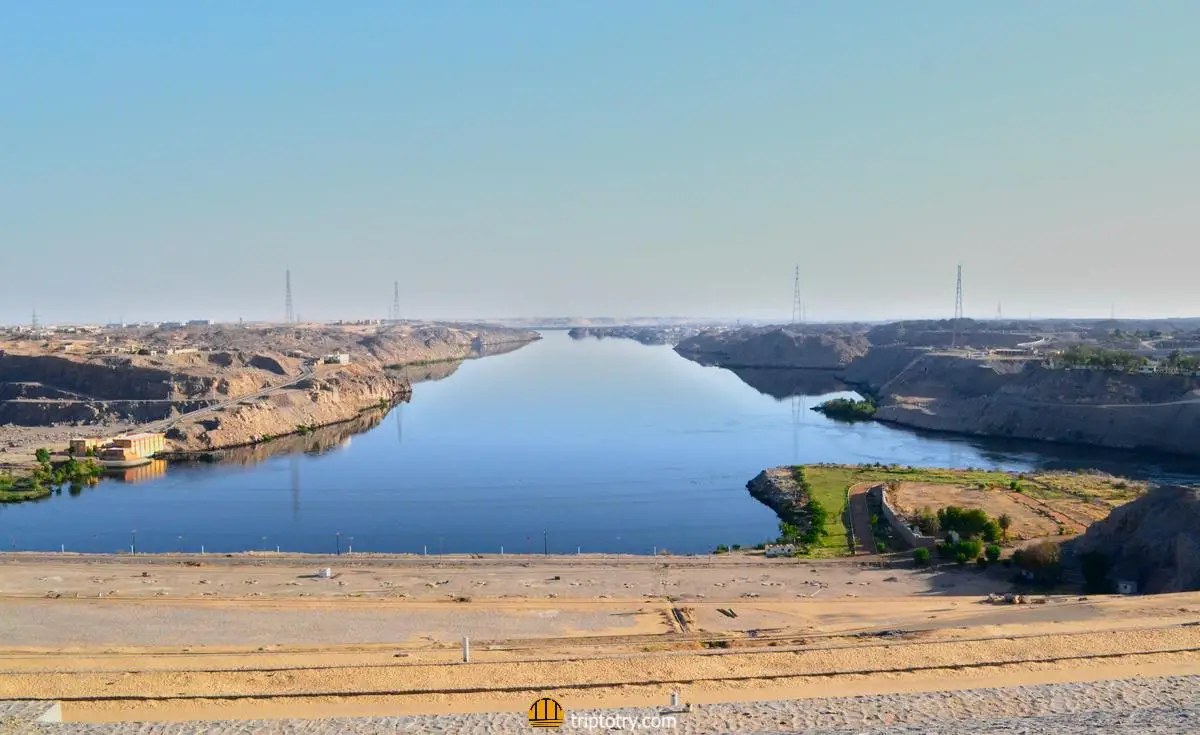
Aswan Dam
After visiting the dam, the second stop on this fourth day of our 7-day trip to Egypt is the Temple of Philae.
This temple built on water was moved from the island of the same name to the island of Agilkia following the construction of the first Aswan Dam.
The temple of Philae, like that of Kom Ombo, also dates back to the Ptolemaic/Roman era.
The temple is dedicated to the goddess Isis, the goddess of love. There is also another small temple in the complex dedicated to the goddess Hathor and Trajan’s kiosk.
Unfortunately, this temple has also been significantly damaged, with many depictions of the gods completely chiseled away.
The temple of Philae can only be reached by boat from the village marina Nagaa Suhayl Gharb, which makes a visit to this temple very atmospheric from the first moments.
Opening hours: 7 a.m. to 3 p.m.
Entrance fee: 450 EGP(about €8.60)
After a visit to the Temple of Philae and a break for lunch, we will depart by felucca, the typical Egyptian river boat. , to sail down the Nile and take a break from ancient Egyptian history and see some glimpses of modern-day life. Starting from Aswan and heading south you can sail along Elephantine Island where the Old Cataract Hotel is located, where several scenes of the movie “Murder on the Nile” were filmed, see the Aswan Botanical Garden, and see some of the Nubian villages built on the west bank opposite the city.
We recommend visiting the Nubian village Nagaa Suhayl Gharb, for an immersion in the colors that distinguish this people, very different from the northern Egyptian people. All Nubian homes are brightly colored and the community is smiling and welcoming. Unfortunately, the integration of the Nubian people with the Egyptian people is proceeding very slowly, mainly due to a distrust on the part of the Nubian people who were forced to leave their lands because of the construction of the Aswan Dam.
Although less well known, this experience was one that we enjoyed the most and one that we recommend you do not miss during your 7-day trip to Egypt; it will allow you to learn about a different side of this people’s culture.

WANT TO ENJOY THE SUNSET OVER THE NILE WHILE SAILING ON A FELUCCA?
⛵ Buy a 2-hour tour on the felucca HERE.

Temple of Philae
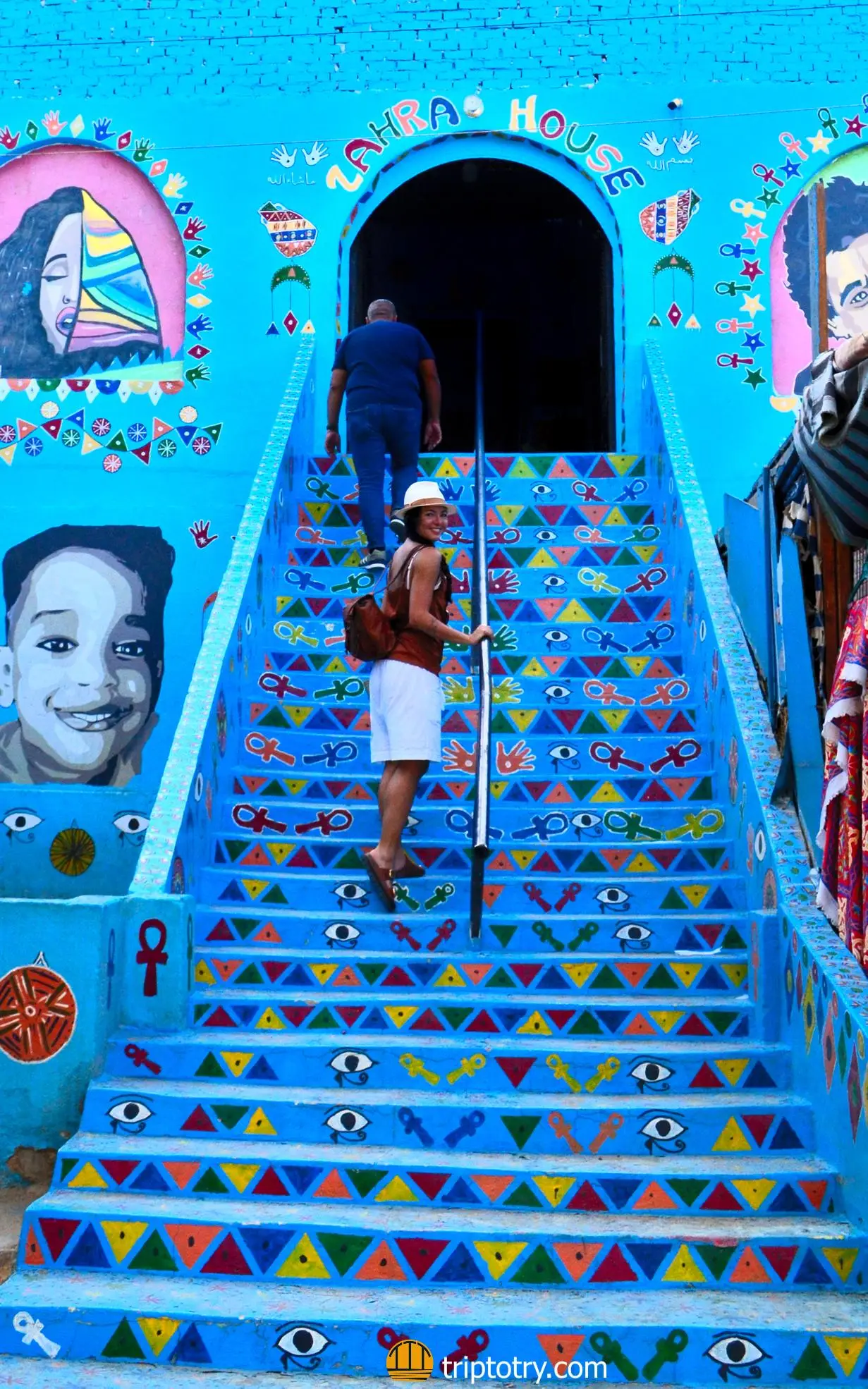
Nubian Village
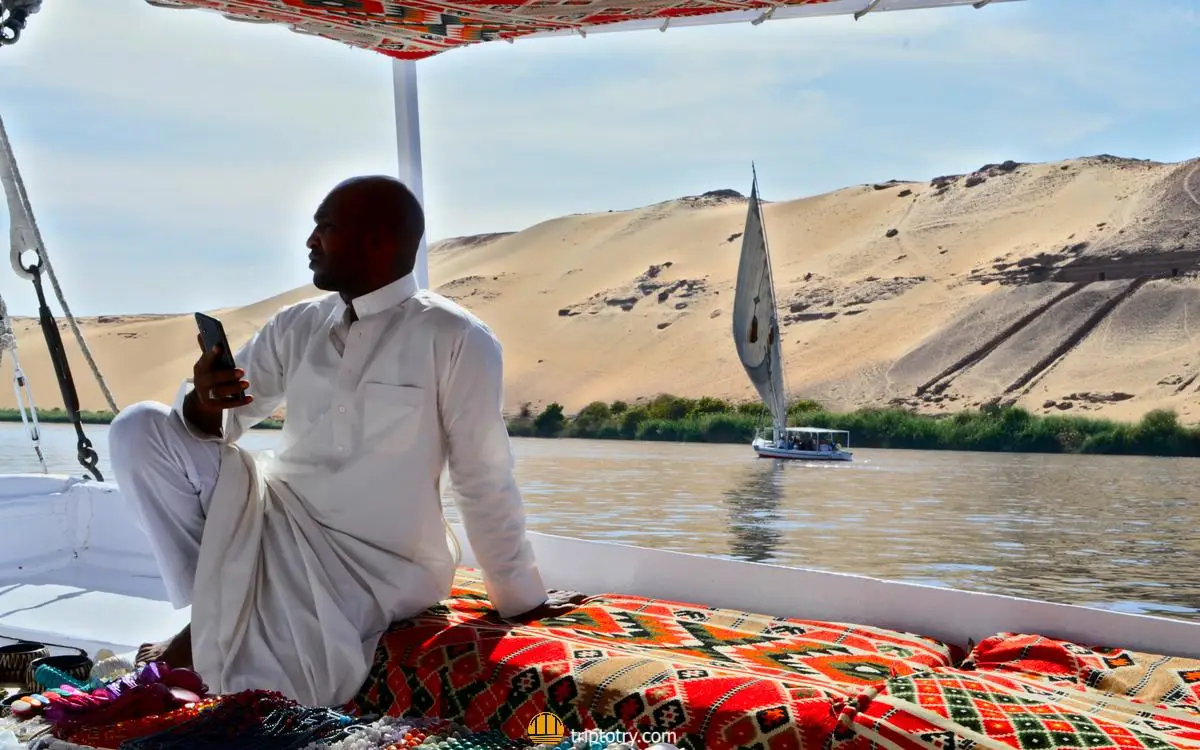
Felucca sailing
Day 5 of our 7-day Egypt itinerary begins with a sunrise wake-up call to set off for Abu Simbel. The trip from Aswan to Abu Simbel takes approximately 3 hours.
The whole day is devoted to visiting this exceptional place, the one that (in our personal opinion) will surely leave you speechless. Although the journey to Abu Simbel is long, we assure you that it is absolutely worth it and that this site is a must on a 7-day itinerary in Egypt.
At the archaeological site of Abu Simbel, currently located on Lake Nasser, there are two temples: the main one erected in honor of Ramses II and the temple of Nefertari, the wife of Ramses II.
The temple dedicated to Ramses II is larger in size and has an imposing facade where 4 statues of Ramses II stand out 20 m high. Inside the temple are in succession the hall of columns, again representing Ramses II, a second smaller hall, and finally the sanctuary.
The original location of the temple allowed a ray of sunlight to enter the sanctuary twice a year, after the temple was moved (again because of the problems created by the Aswan Dam), this phenomenon always occurs twice a year but on different days.
The smaller temple, dedicated to Nefertari and the goddess Hathor, is smaller but the decorations inside are equally beautiful, starting from the first hall, the one of the columns, and continuing into a second, smaller hall, to the one where there are depictions of the goddess Hathor as a heifer being ferried down the Nile.
While the first temple depicts more scenes of Rameses II’s wars and battles to exalt his power, the second contains decorations depicting moments from the daily lives of the couple.
Opening hours: 6 a.m. to 4 p.m., 6 a.m. to 3 p.m. during Ramadan
Entrance fee: 600 EGP(about €11.40)
Our tips: the Abu Simbel temples are very popular with tourists, so we recommend visiting them early in the morning if you can and buying skip-the-line tickets in advance
Once you have finished visiting the Abu Simbel temples, you have two options:
We opted for the second option, even though it involved a dawn wake-up call, because our guides had absolutely advised us not to miss the light and sound show in Abu Simbel and, in our opinion, it was the right choice.
If you also decide to stay in Abu Simbel, the light and sound show should be booked a bit in advance and, if you can, get your tickets before entering so that you don’t have to queue (we put you in link further down). The show starts at about nine o’clock and will show you the story of Ramses II and Nefertari, as well as give you an incredible view of Abu Simbel illuminated at night.

HAVE WE CONVINCED YOU TO STAY FOR THE LIGHT AND SOUND SHOW AT ABU SIMBEL?
🌙 Buy your admission ticket for the Abu Simbel night show HERE.

💰Low budget: Osiris Guest House
💰💰Medium budget: Kabara Nubian House
💰💰💰💰No limits: Seti Abu Simbel Lake Resort ⭐Trip To Try Choice

Here are 9 tips for visiting the Abu Simbel Temples in Egypt: from where they are located to how to get there and where to sleep!
The first stop in Cairo on our 7-day Egypt itinerary is the site of some of the country’s oldest pyramids, Saqqara. The site of Saqqara is located outside Cairo and, although less well known, we definitely recommend that you include this visit on your 7-day Egypt discovery trip. This is because, as you will see, the interiors of the pyramids are better preserved than those at Giza and more ornate.
Saqqara dates back to the time of the Old Kingdom and here you will be able to visit the step pyramid of Djoser, one of the earliest “tests” of pyramid making, the pyramid of Unas, whose interiors are wonderfully decorat, the necropolis and tombs of nobles, including that of Vizier Mereruka where some scenes of daily life, hunting of hippos and animal breeding (including hyenas) are depicted.
Opening hours: 8 a.m. to 4 p.m., 6 a.m. to 3:30 p.m. during Ramadan
Entrance fee: 450 EGP(about €8.60)
The second stop on this sixth day of our itinerary is the world-famous Giza Plain, where you will see one of the seven wonders of the world: the Sphinx and the pyramids of Cheops, Chephren and Mycerinus. To gain access to the site you will have to buy an entrance ticket, which does not include access to the pyramid of Cheops, which you will have to buy separately.
The pyramid of Cheops is the only one accessible, walking down a long, narrow, low corridor (if you suffer from claustrophobia we advise against entering) until you reach the burial chamber, where the sarcophagus is located. As we have already anticipated, the interior of the pyramid is not as ornate as that of the pyramids of Saqqara, but the size is absolutely imposing and, in our opinion, making the tour of the interior is an experience to be had!
Opening hours: 6 a.m. to 4 p.m., 6 a.m. to 3:30 p.m. during Ramadan
Entrance fee: 540 EGP(about €10.30)
Our advice: it is inevitable to queue at the entrance to the pyramids, unless you have already purchased a ticket. An excellent alternative is to join an organized tour (tickets included) that will allow you to visit both Saqqara and Giza.
After a lunch break (which we recommend in Giza, at the restaurant “9 Pyramids Lounge,” which has a terrace with a fantastic panoramic view), we continue to the third stop: the Tomb of the Unknown Soldier memorial, a modern monument but one that in its shape resembles that of a pyramid. This monument was built in memory of those who fell during the War of Logage and the Kippur War, at the behest of former President Sadat, who was assassinated at a rally here.
After a short visit to this monument, we head to the beating heart of the city: the Islamic Quarter, a must-see if you visit Egypt in 7 days. Cairo’s Islamic Quarter is part of the Unesco World Heritage Site and is partly surrounded by the ancient walls, where the main entrances leading to the streets of the quarter are located, which revolve around Al Mu’izz Li-Din Allah Street.
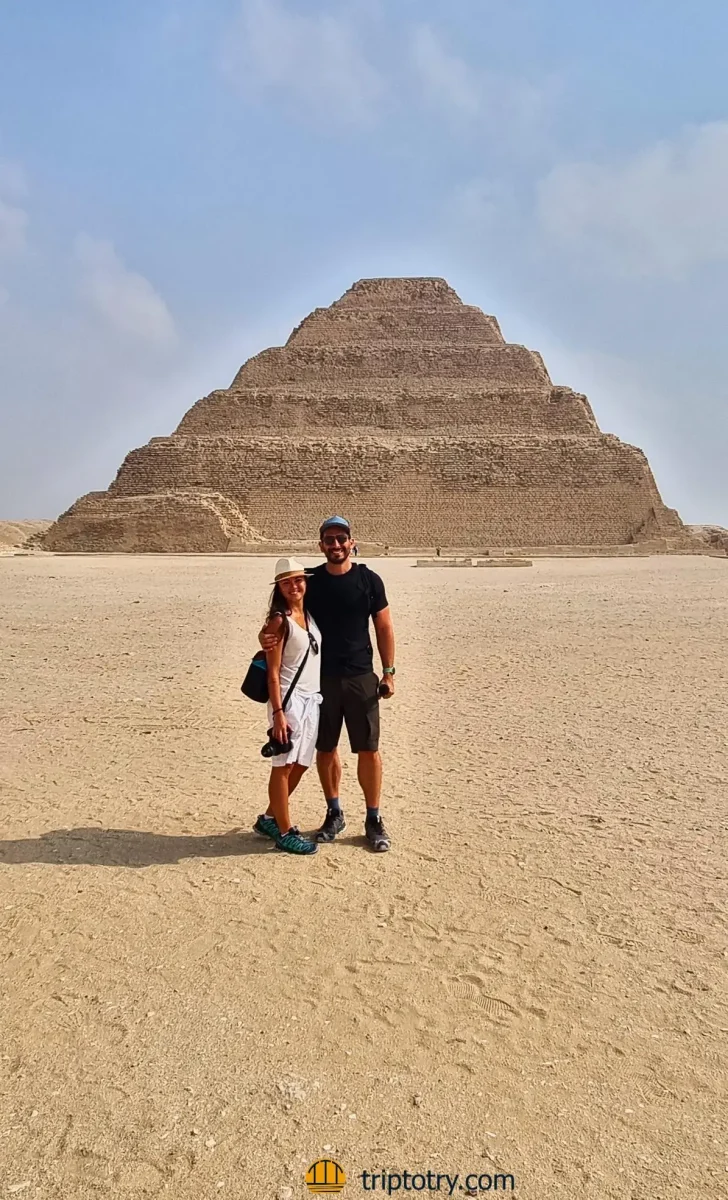
Step Pyramid of Djoser at Saqqara
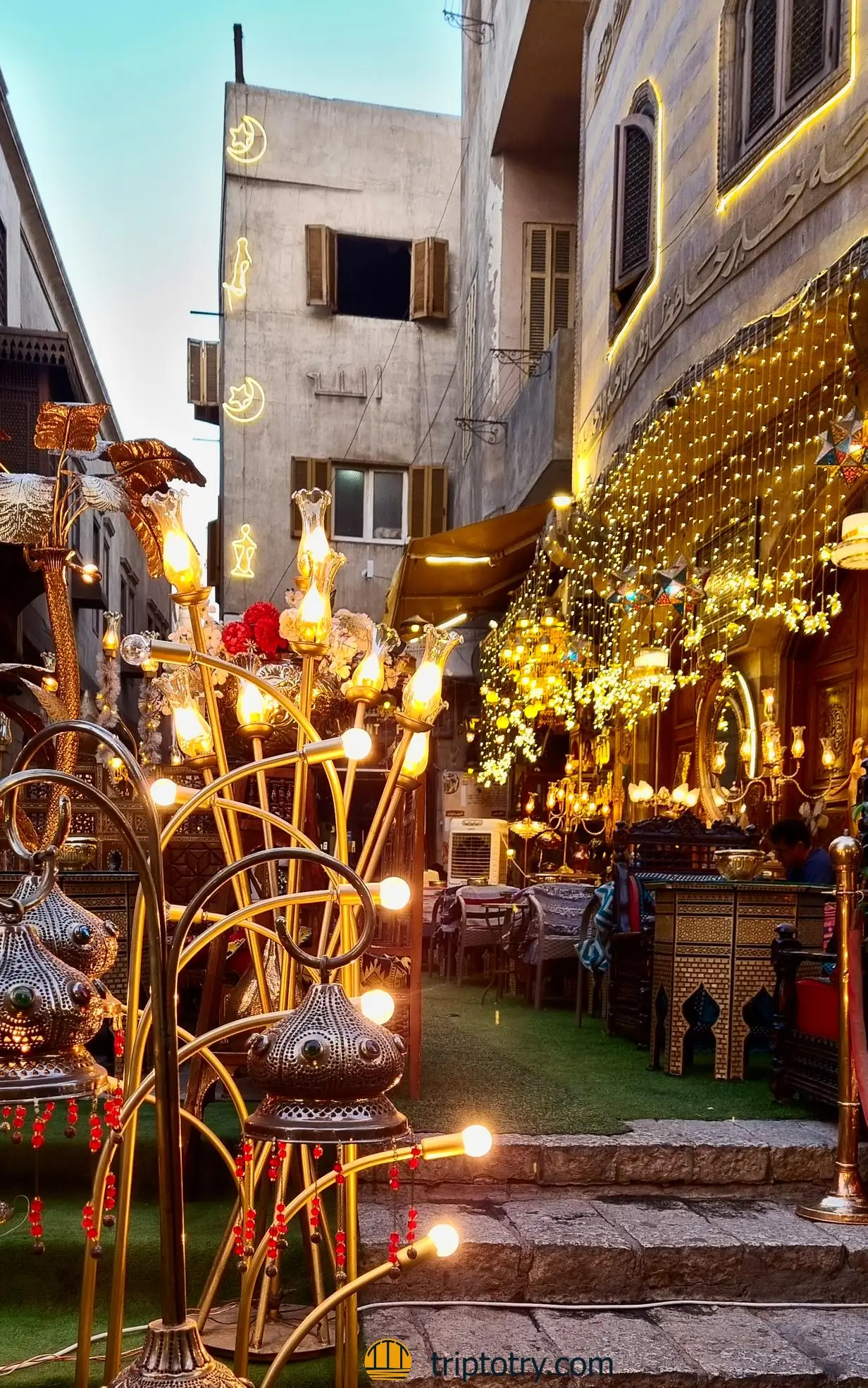
Islamic Quarter of Cairo
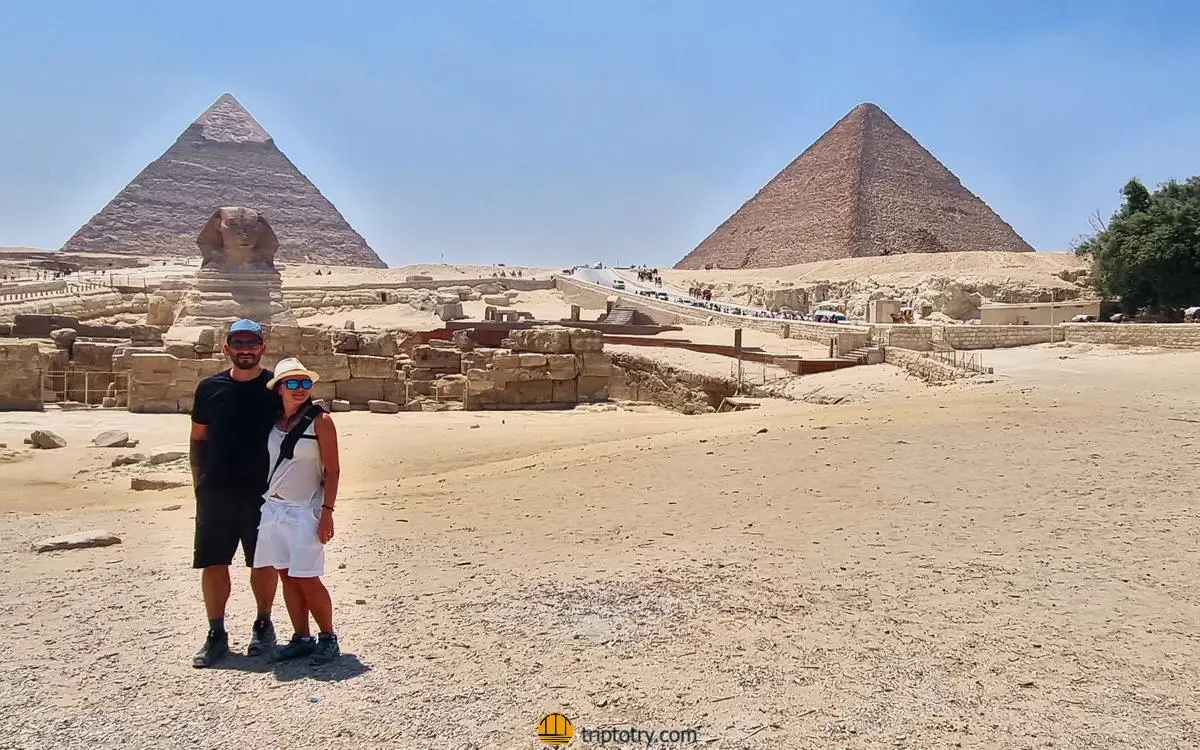
Giza Plateau
We recommend that you visit one of the few mosques open to tourists located in the neighborhood within walking distance of the walls, the Sultan Al-Ashraf Barsbay Mosque. The heart of the Islamic quarter is a veritable open-air museum of mosques, museums and mausoleums and is located at the intersection of Al Mu’izz Li-Din Allah Street and Beet al Qadi Street.
In general, we recommend that you make this visit at sunset, which will make your walk through the Islamic Quarter even more impressive.
From the Islamic Quarter, we continue to the last stop on this sixth day of our “Egypt 7-Day Itinerary” and return to the world of today, visiting the modern district of El Korba Square. Here you will find avenues (quite busy) along which you will find various stores and markets open in the evenings as well as bars and restaurants. We recommend you take a nice walk down Nafak El Sarwa Street and continue along Baghdad Street until you reach the el-Orouba Presidential Palace.

💰Low budget: Cheristo Pyramids view inn
💰💰Medium budget: Egypt Pyramids Inn ⭐Trip To Try Choice
💰💰💰💰No limits: Fairmont Nile City
The first stop on this final day of our 7-day Egypt itinerary is the magical Saladin Citadel. This complex is home to the iconic Muhammad Ali Pasha Mosque, which towers over Cairo with its 84-meter-high minarets and silver-clad domes. Saladin’s Citadel was originally a medieval military fortress. In fact it sits on a hill from which the entire city could be seen, and was built by Sultan Salah al-Din al-Ayyubi (Saladin).
In the Citadel you can visit various buildings open to tourists, such as the Military Museum and the al-Nasir Muhammad Mosque. But the main attraction is definitely the wonderful Muhammad Ali Pasha Mosque, also known as the “Alabaster Mosque” The prayer hall and inner courtyard are lavishly decorated with great elegance. On the way out of the mosque, you can enjoy a beautiful view of Cairo (if you are lucky, also of Giza).
Opening hours: 6 a.m. to 4 p.m., 6 a.m. to 3:30 p.m. during ramadan
Entrance fee: 450 EGP(about €8.60)
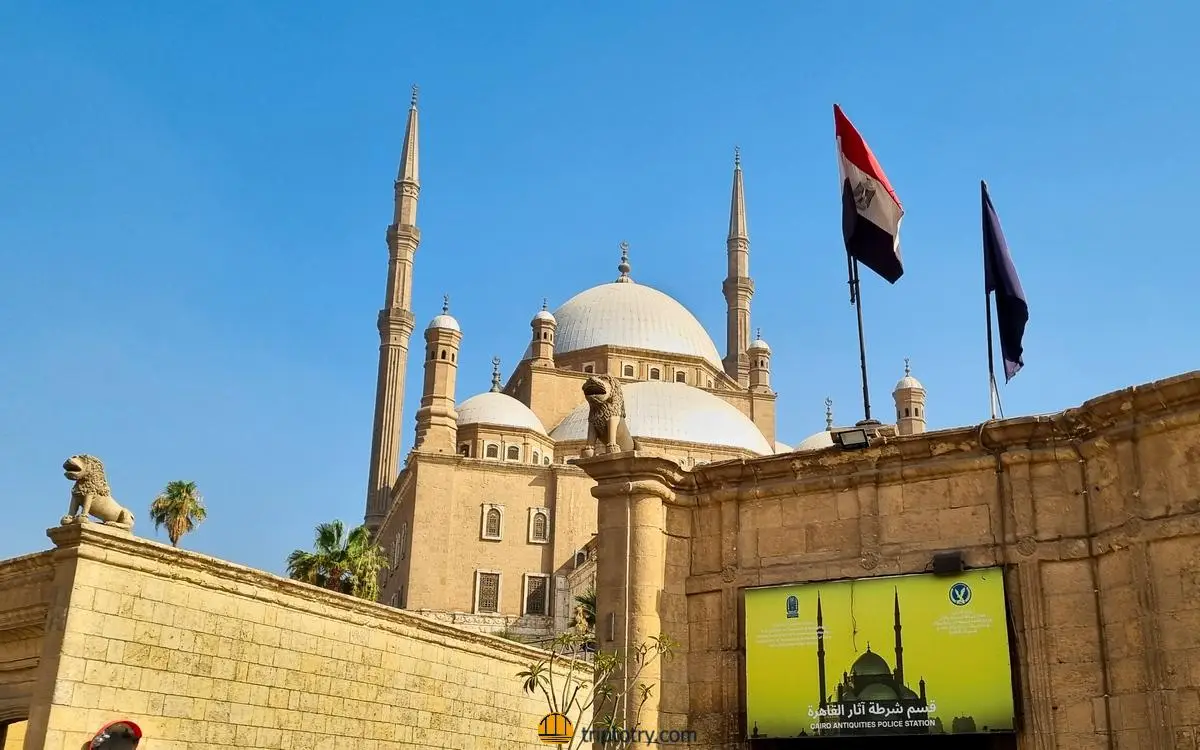
Mosque of Muhammad Ali Pasha
The second stop on this last day of our 7-day itinerary in Egiyyo is St. Simon’s Monastery, built inside the rock of a mountain, which you can reach only by passing through the so-called “garbage collectors” neighborhood, where all the garbage from the city, which has no state collection system, is channeled.
The residents of this neighborhood do an important job for the city, which is passed down through the family, sorting all the garbage, some of which is resold. In fact, they live in conditions of extreme poverty and ill health: walking through this neighborhood is a very touching experience that will leave you incredulous, but we think that knowing even the negative aspects of a place is something important.
To reach the central part of the monastery, you will have to enter the large entrance carved into the wall and walk down a path that descends to the very large amphitheater topped by the mountain wall.
Opening hours: 6 a.m. to 7 p.m.
Entrance fee: free of charge
After visiting the monastery, our “Egypt 7-Day Itinerary” takes us to a place that is high on the list of what to see in Egypt in 7 days: the Egyptian Museum.
The Egyptian Museum in Cairo has been open since the early 1900s and is one of the largest museums in the world, and you will need at least two to three hours to visit at least the main sections. The sections of the museum run chronologically through ancient Egyptian history, and certainly one of the most famous rooms is the one containing the artifacts found inside Tutankhamun’s tomb, located in the Valley of the Kings. In this room (where you will not be able to take filming or photographs) you can admire the pharaoh’s mask made of solid gold, the “matryoshka” sarcophagi inside which the mummy (which you saw in the tomb in the Valley of the Kings) was found, and all the trousseau that was present inside the chamber.
Following the tour inside the museum will allow you to immerse yourself in the ancient history of the Egyptian people, starting 5,000 years ago, a truly interesting journey to discover a brilliant and fascinating culture.
Opening hours: 9 a.m. to 4 p.m., 9 a.m. to 3 p.m. during Ramadan period
Entrance fee: 450 EGP (approximately 8.60 euros)
Our advice: buy your ticket online in advance so you don’t have to queue. Visiting the museum takes a lot of time so we recommend that you plan at least 2-3 hours to see the main things.
Once you have finished your visit to the Cairo Museum, we head to the last stop on our 7-day itinerary in Egypt, which is located in the Islamic quarter: the Khan el-Khalili bazaar. This ancient market, dating back to the 1400s, is the most famous in the city and is a labyrinth of alleyways where stores are lined up one after another with vendors ready to offer you their wares: as you enter this place, know that only one rule applies…bargain to the death! This is the place to buy souvenirs, but you can also find many other products, such as clothing, gold jewelry, spices, perfumes and handicrafts.
Hours of operation: 8:30 a.m. to 11 p.m.
Cost of admission: free (exclusive of shopping!!)
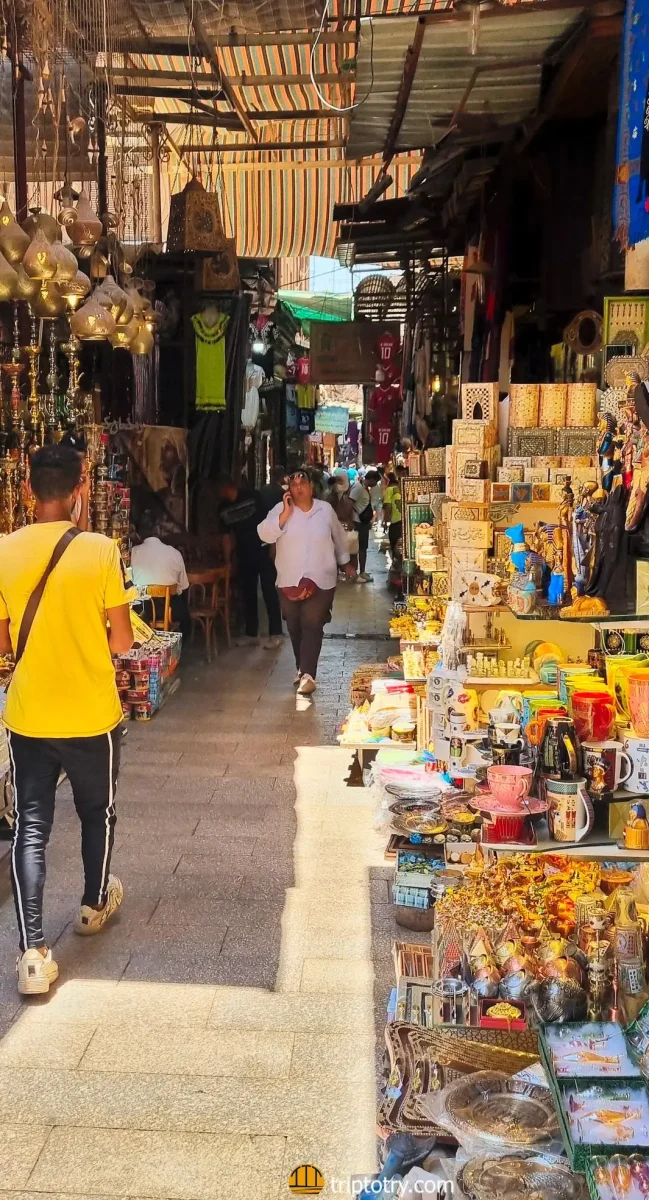
Khan El Khalili Market
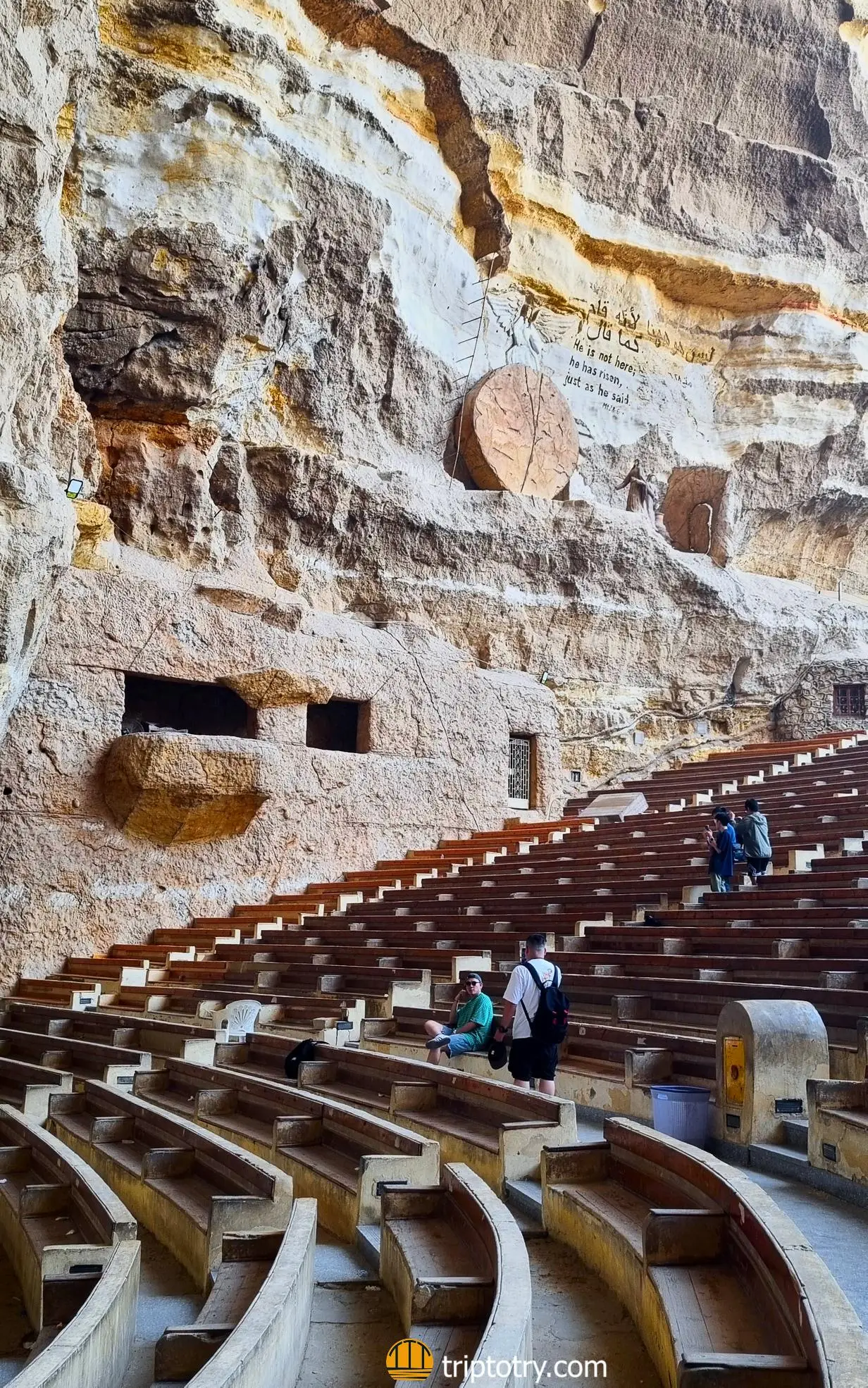
Monastery of St. Simon
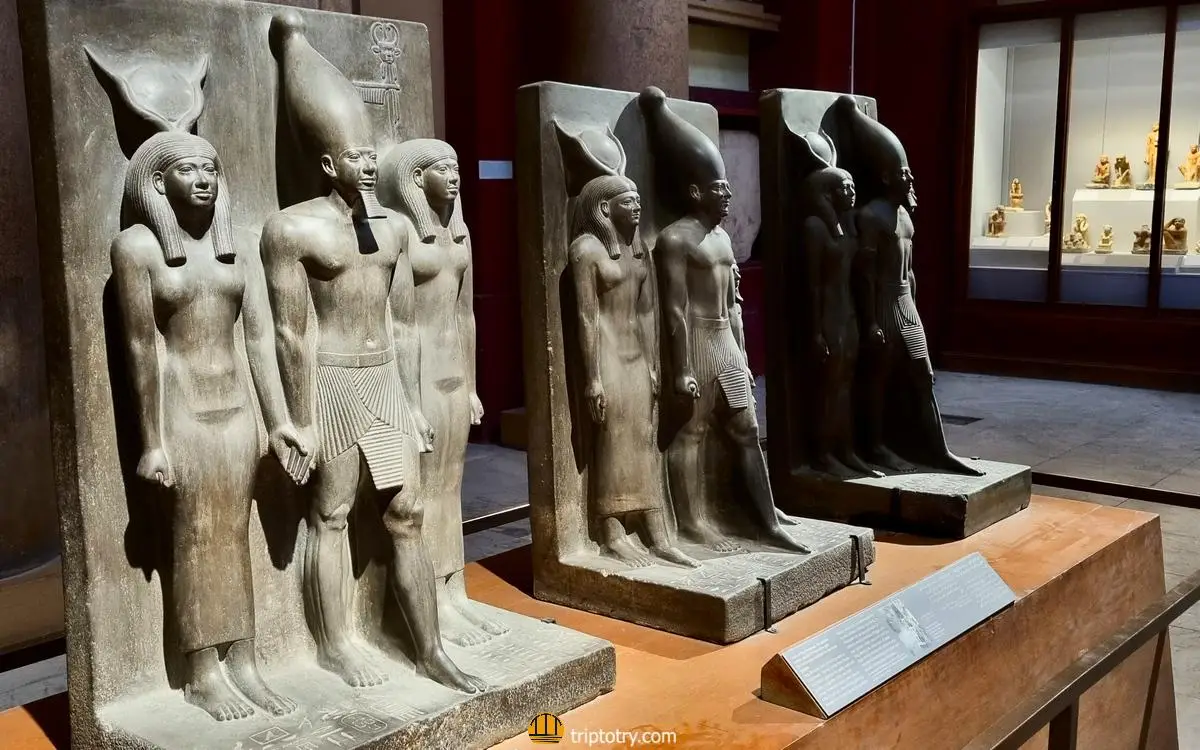
Egyptian Museum
This concludes our 7-day itinerary in Egypt, and we hope you found this article helpful in planning your trip to discover wonderful Egypt! As you have been able to read there are so many places to visit, besides the best known and famous ones, and we assure you that a trip to discover this country will be a unique and truly interesting experience. Stay connected with us via social media and the newsletter and, as always…trip to try!
As travellers, we only recommend products we really believe in. Some links in this post are affiliate links, which means we earn a small commission if you make a purchase, at no additional cost to you.
Thank you for supporting us and helping us to continue to share our adventures and high quality content!